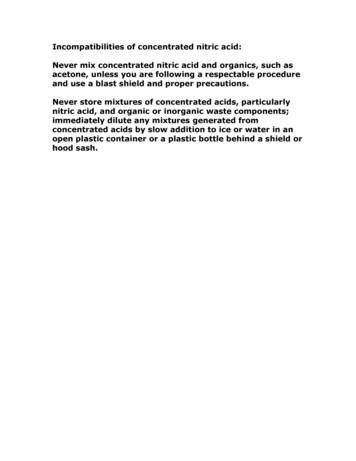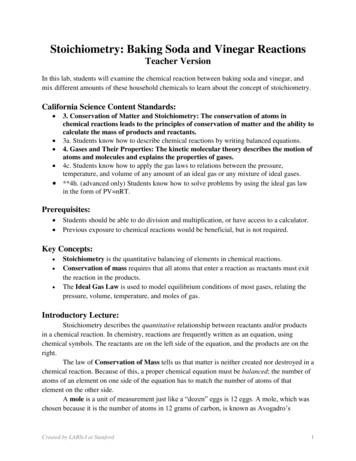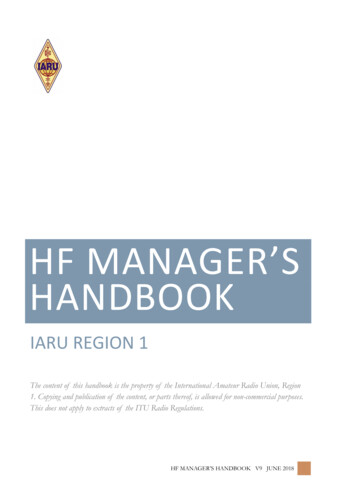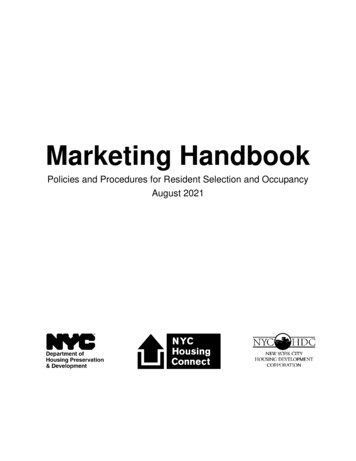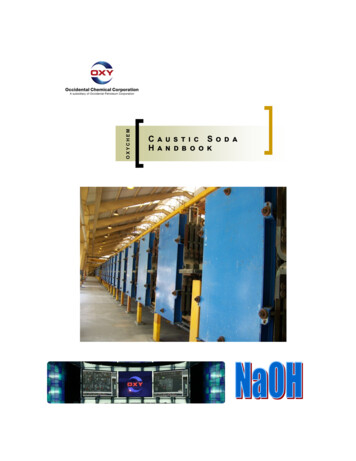
Transcription
OXYCHEMCaustic SodaHandbook
Occidental Chemical Corporation (OxyChem) is a leading North American manufacturer of polyvinylchloride (PVC) resins, chlorine and caustic soda — key building blocks for a variety of indispensableproducts such as plastics, pharmaceuticals and water treatment chemicals. Other OxyChem productsinclude caustic potash, chlorinated organics, sodium silicates, chlorinated isocyanurates and calciumchloride. OxyChem’s market position is among the top three producers in the United States for theprincipal products it manufactures and markets. Based in Dallas, Texas, the company hasmanufacturing facilities in the U.S., Canada and Latin America.OxyChem has been an active participant in the American Chemistry Council's Responsible Care initiative since its inception in 1988. Demonstrating their commitment to attaining the highest levels ofsafety and environmental achievement, Responsible Care companies implement world-classmanagement systems, measure performance based on industry-wide metrics, and are subject toreview by independent auditors.ForewordThis handbook outlines recommended methods for handling, storing, preparing and using caustic soda.It also includes information on the manufacture, physical properties, safety considerations andanalytical methods for testing caustic soda. Additional information and contacts can be found on theinternet at www.oxychem.comImportant: The information presented herein, while not guaranteed, was prepared by technicalpersonnel and is true and accurate to the best of our knowledge. NO WARRANTY OFMERCHANTABILITY OR OF FITNESS FOR A PARTICULAR PURPOSE, OR WARRANTY ORGUARANTY OF ANY OTHER KIND, EXPRESS OR IMPLIED, IS MADE REGARDING PURITY,PERFORMANCE, SAFETY, SUITABILITY, STABILITY OR OTHERWISE. This information is notintended to be all-inclusive as to the manner and conditions of use, handling, storage, disposal andother factors that may involve other or additional legal, environmental, safety or performanceconsiderations, and Occidental Chemical Corporation assumes no liability whatsoever for the use of orreliance upon this information. While our technical personnel will be happy to respond to questions,safe handling and use of the product remains the responsibility of the customer. No suggestions foruse are intended as, and nothing herein shall be construed as, a recommendation to infringe anyexisting patents or to violate any Federal, State, local or foreign laws.2
TABLE OF CONTENTSIntroduction4Principal Uses5Manufacturing6Methods of Shipping10Safe Handling11UnloadingUnloading railcarsHeating a railcarBottom unloading using gravityBottom unloading using pressureTop unloadingUnloading tank trucks14141619202022Equipment for Handling24Technical DataTable 1 Density and NaOH content of membrane grade caustic soda solutions at 60 FTable 2 Density and NaOH content of diaphragm grade caustic soda solutions at 60 FTable 3 Specific heats of caustic soda in Btu/lb· FGraph 1 Boiling and solidifying temperature of aqueous caustic soda solutionsGraph 2 Specific gravity of aqueous caustic soda solutionsGraph 3 Viscosity of aqueous caustic soda solutionsGraph 4 Vapor pressure of aqueous caustic soda solutionsGraph 5 Approximate resultant temperature when diluting caustic sodaGraph 6 Relative enthalpy of aqueous caustic soda solutionsGraph 7 Solubility of sodium chloride in aqueous caustic soda solutionsGraph 8 Thermal conductivity of aqueous caustic soda solutionsGraph 9 Specific conductance of aqueous caustic soda solutions28282930313233343536373839Dilution Calculations40Methods of AnalysisDetermination of the total alkalinity of caustic sodaDetermination of sodium hydroxide in caustic sodaDetermination of sodium carbonate in caustic sodaDetermination of sodium chloride in caustic sodaDetermination of iron in caustic sodaDetermination of other elements in caustic soda43434649535862Billing for liquid caustic soda63Bibliography64
INTRODUCTIONCaustic soda (sodium hydroxide or NaOH) is most commonly manufactured by the electrolysis of asodium chloride (NaCl) solution. OxyChem manufactures caustic soda using either membrane ordiaphragm electrolytic cells. OxyChem does not use mercury based electrolytic cells to produce causticsoda. The co-products formed from the electrolytic production of caustic soda are chlorine and hydrogen.Liquid caustic soda is available as a 50% solution in two main grades. The names of these main gradescorrespond to the electrolytic cells used to produce the caustic soda; membrane grade and diaphragm grade.OxyChem can also provide dilutions of various concentrations.The major difference in the two main grades is the amount of starting material (sodium chloride) remainingin the final product. Membrane grade caustic soda will have less than 100 ppm of the sodium chlorideremaining in the product. Diaphragm grade material will have less than 1.2% sodium chloride. Severalother differences can be seen in the products when the specification sheets are compared. Specificationsheets for each grade can be found on our website at www.oxychem.com.All OxyChem’s caustic soda meets the test requirements specified in the Food Chemicals Codex(FCC). Not all OxyChem’s caustic soda is produced following all cGMP (current Good ManufacturingPractices) requirements as defined by the FDA (Food and Drug Administration). OxyChem doesproduce a food grade caustic soda, which is produced following cGMP requirements as defined by theFDA. OxyChem does not represent or warrant general compliance of this product for food use. Eachprospective use of a product in a food or food related application must be carefully assessed againstappropriate regulations by the user and it cannot be assumed that products meeting FCC testrequirements are satisfactory for all uses without such assessment.OxyChem has played a leading role in providing caustic soda to meet the increasing demands of industry.OxyChem plants are strategically located to conveniently and economically serve industry.Caustic soda is shipped via pipelines, tank trucks, railcars, barges and ships. Terminals are used to maintainstocks of our caustic soda in many principal cities. Distributor stocks are also available in these andmany other cities and form a network of supply for the end user’s convenience.The largest users of caustic sodaare the pulp and paper, detergentand chemical industries. Causticsoda is also used in the alumina, oiland gas and textile industries,mostly for its alkalinity value. MembraneDiaphragm 4
PRINCIPAL USES AND CONSUMPTION OF CAUSTIC SODACaustic soda is one of the very few chemicals utilized in a very broad range of applications. Some principalproducts or processes in which caustic soda is used are:Acid NeutralizationChemical Manufacture of:Agricultural ChemicalsAmmoniaAluminumAmyl AminesBattery RecyclingCresolBleachEthylene AminesBoiler CompoundsFormic AcidCellulose FilmGlycerineDetergentsMaleic AnhydrideDrain CleanersPentaerythritolDrilling MudsPhenolDyestuffsPropylene OxideFood ProcessingPolycarbonatesFruit & Vegetable PeelingSalicylic AcidGlass-Batch WettingSodium AluminateIon-Exchange Resin RegenerationSodium HydrosulfideOre Floatation and ProcessingSodium HypochloritePaint RemoversSodium PhosphatesPetroleum RefiningStyrenepH AdjustmentVinyl Chloride MonomerPharmaceuticalsPigmentsPulp & PaperRayonSoapSurfactantsTextile BleachingVegetable Oil ProcessingWater Treatment
MANUFACTURING PROCESSCaustic soda is produced by OxyChem by an electrolytic process as shown in the following diagrams. Brine,prepared from sodium chloride (NaCl), is electrolyzed in either a membrane cell or a diaphragm cell. Theproduction of caustic soda (NaOH) also results in the co-products of chlorine and hydrogen.In the membrane process, a solution of approximately 33% in strength is formed. The solution is thensent to evaporators, which concentrate it to a strength of 50% by removing the appropriate amount ofwater.MEMBRANE CELL FLOW DIAGRAMSalt (NaCl)Brine TreatmentTreated BrineChlorinegasSulfiteDechlorinationDepleted BrineRiver WaterWater TreatmentDeionized WaterHydrogengasElectrolysis(Membrane Cell)33% Cell LiquorEvaporationCoolingCondensateCarbon DioxideCarbonate LiquorProductionCarbonate Liquor650%MembraneCausticSoda
MANUFACTURING PROCESSMEMBRANE CELL
MANUFACTURING PROCESSThe diaphragm process is similar to the membrane process except that a solution of only 12% is formedin the cell. Again, additional evaporation is required to reach the saleable concentration of 50%.DIAPHRAGM CELL FLOW DIAGRAMRiver WaterWater TreatmentClarified WaterChlorinegasSalt (NaCl)Brine TreatmentTreated BrineHydrogengasElectrolysis(Diaphragm Cell)12% Cell ltrationSaltCondensateCarbon DioxideCarbonate LiquorProductionCarbonate Liquor8
MANUFACTURING PROCESSDIAPHRAGM CELL
SHIPPING METHODSLiquid caustic soda is available from OxyChem’s many plants and terminals in tank truck, rail tankcar, barge and ship quantities. Each form of transportation has its own advantages. The type ofservice selected will depend upon such factors as size and location of storage, rate of consumption,plant location, freight rates, etc.Liquid caustic soda is regulated by the U.S. Department of Transportation (DOT) and isclassified as a corrosive material. The DOT identification number is UN I824 for liquid causticsoda.10
SAFE HANDLING CAUSTIC SODACaustic soda in any concentration must be respected by everyone who handles and uses it.Before starting to work with it, the user should be aware of its properties, know what safetyprecautions to follow, and know how to react in case of contact. Accidental exposure to causticsoda may occur under several conditions. Potentially hazardous situations include handlingand packaging operations, equipment cleaning and repair, decontamination following spills andequipment failures. Employees who may be subject to such exposure must be provided withproper personal protective equipment and trained in its use. Some general guidelines follow:1. Read and understand the latest Safety Data Sheet.2. Provide eyewash fountains and safety showers in all areas where caustic soda is used orhandled. Any caustic soda burn may be serious. DO NOT use any kind of neutralizingsolution, particularly in the eyes, without direction by a physician.3. Move the patient to a hospital emergency room immediately after first aid measures areapplied.FIRST AID MEASURESINHALATION: If inhalation of mists, vapors, or spray occurs and adverse effects result, removeto uncontaminated area. Evaluate ABC's (is Airway constricted, is Breathing occurring, and is bloodCirculating) and treat symptomatically. GET MEDICAL ATTENTION IMMEDIATELY.SKIN CONTACT: Immediately flush contaminated areas with water. Remove contaminatedclothing, jewelry and shoes. Wash contaminated areas with large amounts of water. GET MEDICALATTENTION IMMEDIATELY. Thoroughly clean and dry contaminated clothing before reuse. Discardcontaminated leather goods.EYE CONTACT: Immediately flush contaminated eyes with a directed stream of water for as longas possible. Remove contact lenses, if present, then continue rinsing. GET MEDICAL ATTENTIONIMMEDIATELY.INGESTION: If swallowed, do not induce vomiting. For definite or probable ingestion, do notadminister oral fluids. If vomiting occurs spontaneously, keep airway clear. Monitor airway. Volumeresuscitation (IV fluids) and circulatory support (CPR) may be required. Never give anything by mouth toan unconscious or convulsive person. GET MEDICAL ATTENTION IMMEDIATELY.
SAFE HANDLING CAUSTIC SODAPROTECTIVE EQUIPMENTOSHA requires employers to supply suitable protective equipment for employees. When handlingcaustic soda, the following protective equipment is recommended:Wear suitable chemical splash goggles for eye protection during the handling of caustic soda in anyconcentration. The goggles should be close fitting and provide adequate ventilation to prevent fogging,without allowing entry of liquids. The use of a face shield may be appropriate when splashing canoccur, including loading and unloading operations.Wear rubber gloves or gloves coated with rubber, synthetic elastomers, PVC, or other plastics to protectthe hands while handling caustic soda. Gloves should be long enough to come well above the wrist.Sleeves should be positioned over the glove.Caustic soda causes leather to disintegrate quite rapidly. For this reason, wear rubber boots. Wear thebottoms of trouser legs outside the boots. DO NOT tuck trouser legs into boots.Wear chemical resistant clothing for protection of the body. Impregnated vinyl or rubber suits arerecommended.Wear hard hats for some protection of the head, face and neck.If exposures are expected to exceed accepted regulatory limits or if respiratory discomfort isexperienced use a NIOSH approved air purifying respirator with high efficiency dust and mist filters.PROTECTIVE PRACTICESKeep equipment clean by immediately washing off any spill or accumulation of caustic soda.Weld pipelines where practical. Use flanged joints with gaskets made of caustic soda resistant materialsuch as rubber, PTFE, or EPDM rubber. If a screwed fitting is used, apply Teflon tape to the threads.When disconnecting equipment for repairs, first verify that there is no internal pressure on the equipmentand the equipment has been drained and washed.Provide storage tanks with suitable overflow pipes. Overflow pipes should be directed to a protectedoverflow area away from operations.Shield the seal area of pumps to prevent spraying of caustic solutions in the event of a leak.When releasing air pressure from a pressurized system, take every precaution to avoid spurts orsprays of caustic solution.In case of a spill or leak, stop the leak as soon as possible. After containment, collect the spilledmaterial and transfer to a chemical waste area. Remove large liquid spills by vacuum truck. Neutralizeresidue with dilute acid. Flush spill area with water and follow with a liberal covering of sodiumbicarbonate or other acceptable drying agent.12
SAFE HANDLING CAUSTIC SODAHANDLING LIQUID CAUSTIC SODAIn handling caustic soda solutions, care must be taken to avoid solidification which will plug pipelinesand equipment. Graph 1 on page 31 shows the freezing points for solutions of caustic soda at variousconcentrations.Should a caustic soda solution become frozen in process equipment or piping, care must be takenwhen thawing the material. The use of atmospheric pressure steam is suggested. Acceleratedcorrosion can occur in areas where equipment is subjected to extremely high temperatures.
UNLOADING AND HANDLING CAUSTICSODA IN RAILCARSGENERAL INFORMATIONLiquid caustic soda has a markedly corrosive action on all body tissue. Even dilute solutions mayhave a destructive effect on tissue after prolonged contact. Inhalation of mists can cause damageto the upper respiratory tract, while ingestion of liquid caustic soda can cause severe damage tothe mucous membranes or other tissues where contact is made.It is important that those who handle caustic soda are aware of its corrosive properties andknow what precautions to take. In case of accidental exposure, immediately flush the exposedarea with large amounts of water and seek medical attention. For more specific informationrefer to the Safe Handling section of this handbook and in the OxyChem SDS for liquid causticsoda.PLACEMENT OF THE RAILCAR FOR UNLOADING1. After the car is at the loading spot, DOT regulations require that the hand brake be set and thewheels blocked (chocks).2. DOT regulations require caution sign(s) be placed on or next to the rail track to warn personsapproaching the car from the access track end(s). Caution signs must be left up until the railcar iscompletely unloaded and disconnected from the customer’s connections. Signs must be made of metal orother suitable material, at least 12x15 inches in size, and bear the words, “STOP-TANK CARCONNECTED”, or “STOP-MEN AT WORK.”3. It is recommended that a locked switch or derail device be placed at the access track end(s), aminimum of one car length away from the railcar to be unloaded.4. A railcar of caustic soda should only be unloaded when adequate lighting is available.5. A suitable ramp should be used to access the railcar top operating or safety platform. The accessramp chosen should accommodate a variety of platform widths because of variations in rail carmanufacturers, and railcar heights since the railcar will rise while unloading.UNLOADING PRECAUTIONS Before making any connections, verify the content of the railcar is caustic soda. Test the nearest eyewash and safety shower per your facility procedure. Only responsible and properly trained personnel should unload liquid caustic soda. Unloadingoperations must be monitored while the car is connected.14
UNLOADING AND HANDLING CAUSTICSODA IN RAILCARS Since serious burns can result from contact of caustic soda with the eyes and skin, the personalprotective equipment (PPE) listed below is recommended when handling equipment for caustic soda.Based on a job task analysis or job hazard assessment more PPE may be appropriate.Hard hatMono-gogglesFace shieldRubber, steel-toed bootsChemical glovesChemical resistant suitRespiratory protection Make certain the storage tank is vented and has sufficient room available for the contents of theentire railcar. Consider restricting access to the area around the railcar and transfer line to the storage during theactual transfer operation. If a railcar needs to be moved when partially unloaded, DOT regulations require that all unloading linesmust be disconnected and railcar closures must be replaced. A railcar may be sampled either from the top manway, or from the top eductor line using a suitableprocedure. Sampling from the bottom unload piping is not recommended. If a railcar has partially frozenand has been thawed, special sampling techniques may be required due to stratified concentrationsthat may be present. OxyChem’s liquid caustic soda is shipped in insulated and lined railcars. Typical linings have an uppertemperature limit of 225 F. Therefore, recommended ‘trapped steam’ pressure used in the coils to heatup a rail railcar is limited to 15 psig max. Most customers use atmospheric steam in the coils. Unloading lines should insulated and heated when used to transfer liquid caustic soda to storage in coldclimates. The preferred method of heating is to provide electric or steam heat tracing around theunloading line, under the insulation. An alternate method is to provide tees in the unloading line so thatsteam (or hot water) can be run through the unloading line just prior to its use. Use caution using thismethod so as to NOT put water or steam directly into the railcar of caustic soda. NOTE: Runningsteam through unlined steel piping systems can result in increased corrosion and iron pickupin the product. A properly designed and equipped padding system must be used if the railcar will be pad pressureunloaded. Compressed air is the most common padding gas. Nitrogen can also be used but it is morecostly and it has the additional hazard of being an asphyxiant gas, thus extra precautions are required.All fittings used for padding a railcar should be inspected for defects before each use. The air supply system should be oil free, and have a pressure relief valve set at 25 psig, and a pressureregulator set at 18 to 20 psig. The removable connection piping used on the railcar vent valve should alsohave a pressure gauge, a release (vent) valve and a shut off valve.
UNLOADING AND HANDLING CAUSTICSODA IN RAILCARSGeneral purpose caustic railcars are structurally constructed to a 100 psig design and with a burst rating ofapproximately 500 psig. Per 49 CFR 179.15, caustic railcars can have a pressure relief device installed thatis set for 75 to 165 psig. The lower rated relief devices are sometimes hydraulically activated during roughtransport handling, and can release some liquid onto the jacket area.Even though they are designed and equipped as stated, these are NOT pressure railcars and should not bepadded above the OxyChem and the Chlorine Institute recommended range of 20 to 25 psig max.At OxyChem after a railcar is loaded with product, it is padded up to approximately 30 psig and leakchecked to meet the DOT shipping requirement. That test pad pressure is released prior to shipping.Because of inherent shaking and jarring experienced by the railcar and contents during the shippingprocess, gaskets and joints can loosen up and customers should be cautious of that possibility. If pressureunloading, particular areas to watch are the manway gasket, the bottom flange gasket (when bottomunloading), and the top operator stuffing box gland area for the bottom outlet valve (BOV) if so equipped.Additionally, the top operated bottom outlet valve reach rods can, in rare instances, come detached duringtransit. There have been reports that these detached rods can be pushed up from a railcar if unloadingpressures greater than 30 psig are used.HANDLING IN COLD WEATHERSince OxyChem tank cars are well insulated and liquid caustic soda is loaded hot ( 100F ), product usuallyarrives at its destination in a liquid state. However, since 50% liquid caustic soda begins to crystallize at 54 F, incases of unusual delays in transit, partial freezing may take place in cold weather.A temperature measurement of the caustic soda is the best indication if steaming is required. If the railcarproduct is 65 F or cooler, heating is recommended prior to unloading. Even if all liquid, it may flow poorly due toits higher viscosity.If a railcar temperature is over 65 F but product will not flow from the BOV (bottom unloading), try applying asteam lance for a few minutes to the BOV and auxiliary valve. This uninsulated piping area is prone to freezing.If freezing has occurred, the following procedure should be used:1. Vent the railcar – OxyChem recommends opening the railcar manway cover.2. Connect a steam line to the bottom jacket connection pipe, and/or at the BOV connection. Connect acondensate return line at the steam condensate outlet pipe. If a steam trap is used on the exit of arailcar, OxyChem recommends regulating the steam pressure into the coils to a maximum of 15psig. This is to protect the lining from excessive spot heating, which will damage the lining. If acondensate return line is not used, the condensate must be disposed of or otherwise utilized in amanner compliant with all environmental regulations.16
UNLOADING AND HANDLING CAUSTICSODA IN RAILCARSThe amount of material that is frozen in a caustic soda rail car is dependent upon the outsidetemperature, wind chill, and the time elapsed between when the railcar was loaded and is unloaded.In very cold winter conditions, it is possible for a caustic soda railcar to be totally frozen. For this case,it may be necessary to steam the rail car for as long as three days (72 hours) to fully liquefy all of thecontents.A temperature measurement is the best indication as to when the contents have liquefied and thecaustic soda is ready for unloading. The recommended minimum unloading temperature of 50%caustic soda is 70 F. At 70 F through 90 F steaming may be desirable to reduce viscosity.If the above measures do not liquefy the contents on the railcar, contact your OxyChem technicalrepresentative.ADDITIONAL NOTES FOR HEATING RAILCARS:Do not exceed a steam pressure of 15 psig on the jacket. Certain railcar linings can be damaged using steampressure above15 psig.Do not keep steam on while emptying the railcar. Exposing the steam coils without fluid present todissipate the heat can damage the lining due to local heating.Do not heat the product over 120oF to minimize corrosion of unlined steel piping systems andequipment.
UNLOADING AND HANDLING CAUSTICSODA IN RAILCARS18
UNLOADING AND HANDLING CAUSTICSODA IN RAILCARSUNLOADING RAILCARSThis section provides comments when unloading caustic soda from railcars in three ways: 1) via the bottom outlet valve(BOV) using gravity; 2) via the BOV using pad pressure; or 3) top unloaded through the well line using pad pressure.Refer to Figure 2 for the various unloading arrangements present on a caustic railcar.BOTTOM UNLOADING - GRAVITY1.Verify the contents are liquid and at the desired unloading temperature. If not, see “Handling in Cold Weather.”2.Vent the railcar – OxyChem recommends opening the railcar manway cover.3.Refer to Figure 2A or 2B. Ensure the internal BOV is closed tightly. If a top operated BOV, the valve rodwhich operates the bottom discharge valve has a handle on it which is located at the top of the railcar. Thehandle can be reversed and serves as a cap in transit.4. Remove the plug from the auxiliary valve, then attach an appropriate fitting and unloading line. A flexibleconnection hose is recommended since a railcar will rise as it is unloading.5. Check the downstream unloading line to see that all valves are in the proper position for unloading to storage.6.Open the bottom auxiliary valve, then the internal BOV either by rotating the handle 90 if it is a bottomoperated BOV, or by turning the top operator to allow contents to begin flowing by gravity to the pump or tank.If the BOV does not open upon application of light pressure, frozen caustic soda is probably present in thebottom of the car. Application of steam to the BOV area via a steam lance, or hookup to the heat coils may benecessary. See “Handling in Cold Weather.”7.When the tank car is empty and the discharge pipe has completely drained, close the internal BOV and theauxiliary valve.8.Disconnect the unloading fittings and hose and install the plug tool tight in the auxiliary valve.9.Close the manway cover and secure all bolts tool tight. Close the vent valve if open and install the plug tooltight if removed.10. Prepare the railcar for return.Note: See Figure 3 for an example setup for Bottom Unloading using gravity feed to an unloading pump and thento a storage tank.
UNLOADING AND HANDLING CAUSTICSODA IN RAILCARSBOTTOM UNLOADING – PAD PRESSURECompressed air can be used to increase the flow rate of caustic soda to storage or to transfer product without theuse of a pump. If compressed air is to be used, the prior section instructions for bottom unloading should bemodified as follows:1.Close and secure the manway cover tool tight.2.Remove the plug from the vent valve and connect the air supply piping and flexible hose to it.3.Open the vent valve, and apply air pressure slowly to the railcar until there is a normal flow of liquid to thestorage tank. The pressure should be maintained until the railcar is completely empty. OxyChem recommendsuse of 20-25 psig max. A drop in air pressure or the sound of air rushing through the unloading line indicates therailcar is empty.4.When the railcar is empty, shut off the air supply to the railcar and allow the residual air pad to ventfrom the railcar either through the unloading line, or through the vent valve on the air system piping venting the pad from the railcar to a safe location.5.Close the vent valve on the railcar.6.Remove the air supply line and reinstall the plug tool tight.TOP UNLOADING THROUGH THE EDUCTION (WELL) LINE – PAD PRESSURE1.Verify the contents are liquid and at the desired unloading temperature. If not, see “Handling in Cold Weather.”2.Refer to Figure 2C. Open the housing cover protecting the top unloading valves.3.Remove the plug from the eduction valve, and using appropriate fittings, connect a flexible unloading hose. Thisis necessary since the railcar will rise while being unloaded.4.Remove the plug from the vent valve, and connect the air supply piping and flexible hose to it.5.Open the eduction valve and any other valves necessary to the storage tank.6.Open the vent valve, and apply air pressure slowly to the railcar until there is a normal flow of liquid to thestorage tank. The pressure should be maintained until the railcar is completely empty. OxyChem recommendsuse of 20-25 psig max. A drop in air pressure or the sound of air rushing through the unloading line indicatesthat the tank car is empty.7. When the railcar is empty, shut off the air supply to the railcar and allow the residual air pad to ventfrom the railcar either through the unloading line, or through the vent valve on the air system piping venting the pad from the railcar to a safe location.8.When the railcar is at atmospheric pressure, close the eduction valve and disconnect the unloading line fromthe railcar.9. Close the vent valve and disconnect the air supply from the railcar.10. If desired, open the manway cover to verify the railcar is empty. Do not enter the car to make aninspection.11. Replace both plugs in their respective valves tool tight, and secure the protective housing cover.12. Prepare the railcar for return.20
UNLOADING AND HANDLING CAUSTICSODA IN RAILCARSSee Figure 4 for an example setup for Top Unloading to a storage tank. Care should be taken not to spill causticsoda on the railcar, since it will cause damage to the paint and may endanger workers handling the empty railcaron its return. Wash off any spilled or dripped caustic.PREPARING AN EMPTY RAILCAR FOR RETURN1. Ensure both top valves are closed and plugs are installed tool tight. Secure the cover over thevalves.2. Close the manway cover taking care to ensure the gasket does not fall into the railcar, shift or fold.Ensure all manway cover bolts are tool tight.3. Disconnect any steam lines used to heat the railcar. Do not place any caps or closures on the railcarsteam pipes.4.Make sure the bottom outlet valve (BOV) and auxiliary valve are closed, and the plug is installed tool tight.Return the empty railcar promptly in accordance with the shipper’s instructions. The shipper’s routingdirections must be followed in all instances.
UNLOADING CAUS
Handbook. 2 Occidental Chemical Corporation (OxyChem) is a leading North American manufacturer of polyvinyl . Texas, the company has manufacturing facilities in the U.S., Canada and Latin America. OxyChem has been an active participant in the American Chemistry Council's Responsible Care

